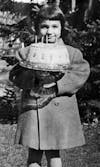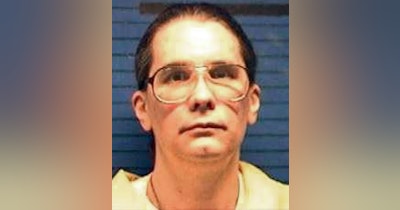December 1957 two seven year old girls were outside in the neighborhood streets of Sycamore, Illinois, playing in the newly fallen snow. They were best friends Kathy Sigman and Maria Ridulph, but witnesses also placed a third, rather unusual playmate with the two girls that wintery evening.
According to Kathy and other witnesses who saw this third, mysterious figure, the girls were already outside playing when a young man in his early twenties approached them. Despite the age gap, the three of them became fast friends, especially when this young man, who introduced himself as Johnny, offered to give the girls piggyback rides.
At some point during the evening, Maria, an honor student in second grade, was so excited about this new friend that she rushed home to grab one of her toys so that she could show it to him. Maria came back, toy in hand, but by then it had started snowing again and her best friend Kathy was getting cold. This time it was Kathy who left Maria alone with Johnny so she could go and get her mittens, but when she came back, everything was completely different.
The streets were empty and both Maria and Johnny were gone.
Kathy walked over to Maria’s house to try to find her friend, but Maria wasn’t there either. Not thinking that anything bad had happened at the time, Maria’s parents first sent out her eleven-year-old brother to go and look for her, but when he came back empty-handed, a full-blown manhunt was soon underway.
Her friends, family and the police scoured the neighborhood, but there was a pit in Maria’s mother’s stomach. She later said: “My daughter was a nervous girl and if she got in any trouble would become hysterical… I am the only one who could calm her down.” Maria was also described as a “screamer” who was easily agitated.
The canvas of the neighborhood came back with nothing and now fearing that Maria had been kidnapped and potentially taken across state lines, the FBI joined the search. Kathy described her new friend Johnny as a young man with a “slender chin, light hair, (had) a gap in his teeth, and (was) wearing a colorful sweater.”
Fearing that Johnny would come back to attack the key witness against him, the FBI put Kathy and her family in a safe house.
They also tightened the timeline for Maria’s possible abduction even further. Witnesses had seen the girls playing alone between 6 and 6:30 that evening and going off of the families’ testimonies from when both Kathy and Maria stopped by their respective homes, Johnny must have approached them after 6:30. This gave a window of about 15 minutes for Maria to disappear into thin air.
And it looked like that’s exactly what had happened.
On April 26, 1958, about five months after that fateful night, two tourists found the skeletal remains of a child near Woodbine, Illinois. She was too badly decomposed to identify right away and it was a combination of her dental records, hair samples and her clothing that led investigators to believe that they had finally found Maria. She was wearing only her shirt, vest and socks and the rest of her clothes were missing.
Due to the terrible condition of her remains, the coroner couldn’t determine the cause of death or if any sexual abuse had occurred.
Realizing now that whatever happened to Maria hadn’t happened across state lines, the FBI withdrew, but not without naming a few suspects first and amongst those was a neighborhood teenager called John Tessier.
John Tessier had actually been born John Cherry in 1939 in Belfast, Northern Ireland. His father was a British sergeant in World War II and was, unfortunately, killed during the early fighting of the war. His mother, Eileen McCullough, was one of the first female plane spotters in the RAF, which is how, after the death of her first husband, she met a member of the American Air-Force called Ralph Tessier.
Eileen and Ralph married four years later and at the end of the war, Eileen and John moved with Ralph to Sycamore, Illinois, where the family would grow even more. Together Eileen and Ralph had six more children and Ralph officially adopted John, making John Cherry now John Tessier.
The Tessier house in Sycamore was just around the corner from the Ridulph family home and if John Tessier having the same name as the mysterious Johnny the girls had been playing with that evening wasn’t enough to make authorities suspicious, it turned out that John already also had a bit of a troubled past. When John was in the tenth grade, he was expelled from school after an incident where he allegedly pushed a teacher and called her an insulting name. At the time of Maria’s disappearance, he was eighteen years old and it wasn’t too long after that there were rumors and more allegations of him threatening to kill one of his sisters and sexually abusing another.
It looked like John was the perfect suspect in the disappearance of Maria, so how come Kathy was never asked anything about him? Why didn’t they even show him in a lineup?
When the police interviewed John and his family in their initial canvas of the neighborhood, John and his mother Eileen told them that he had been home all evening, but when the FBI conducted their own interviews only a few days later, that story had changed. Now John had spent the evening of Maria’s disappearance in Rockford, Illinois, where he had been doing physical examinations to enlist in the Air Force, and he had phone records showing him calling from Rockford and train tickets to prove it. This time it was his stepfather, Ralph, who confirmed John’s alibi and at the time, Ralph was a man of good standing with the Sycamore police. He was the one who painted the local police cars and when he stood up for his stepson, the police believed him.
But the FBI were still unconvinced.
They asked John to come in for a lie detector test and it was only when John passed it that they officially removed him from the list of suspects. Kathy was never even shown a picture of John and he left for the Air Force the very next day after his final interview with authorities.
Thirteen years went by and Maria’s case was nowhere nearer to being solved. John became a captain before retiring from the Air Force and then moved to Seattle, Washington, where he became a policeman. For years John and his chief of police had argument after argument and his boss tried to get him fired on several occasions. He cited a long list of complaints he had about John, his work and his general conduct, but John always managed to wiggle out of the noose at the last moment. It was only in 1982 that John would do something he couldn’t come back from… and it was, unfortunately, quite a big one.
John and his then girlfriend took in a fifteen-year-old runaway named Michelle Weinman. Michelle knew John was a police officer and trusted him enough to live with him when she had nowhere else to go, but she later said that everything changed only a few short days after she’d moved in. Michelle later testified that John had sexually abused her. Now John’s Chief of Police had exactly what he needed to get him out of his department and behind bars.
But John somehow managed to get out of it again.
He’d been charged with statutory rape, which is a felony and should have resulted in jail time, but he and his lawyers managed to work out a deal where John pled guilty to communication with a minor for immoral purposes. That dropped him all the way down to a misdemeanor and he was sentenced to one year probation and fired from the police. That was it. He later found work as a security guard and changed his name to Jack Daniel McCullough in honor of his mother whose maiden name had been McCullough.
This came right on top of his mother Eileen’s long and traumatic death. She’d had cancer and had been taking very powerful painkillers when she made a startling deathbed confession to two of her daughters. “Those two little girls, and the one that disappeared, John did it. John did it, and you have to tell someone,” Eileen reportedly told Janet and Mary Pat, two of John’s half-sisters.
According to her daughters, Eileen was admitting to covering up John’s alleged crimes and now she wanted something done about it. She apparently made Janet promise to take what she now knew to the authorities.
John was asked not to come to his mother’s funeral.
Janet, who was the sister that John reportedly once threatened to kill, spent the next fourteen years trying to get law enforcement to reopen Maria’s case and finally, in 2008, she got what she wanted. With news about Eileen’s deathbed confession, the investigation was back on with Janet leading the siblings, who all had their own sides to tell as well. Two of the older sisters Katherine and Jeanne testified that their mother had lied to investigators about John’s whereabouts that evening. And Jeanne had a bit more to share about John. Jeanne was the sister who claimed that John had sexually abused her as a minor and she said that he’d done the same to other young girls too.
This was a potential motive, especially seeing as Maria had been missing a lot of her clothes when she’d been found. Add that to Maria’s mother’s testimony of Maria being someone who screamed when she was frightened and the motive for murder becomes even stronger.
But Eileen had been incredibly sick and delirious when she’d confessed to covering up for her son and John still had a pretty solid alibi. He had been in Rockford that day. His physical exams and paperwork had been filed that evening and he had the phone call records to prove that there’d been a collect call from Rockford station made in his name. He even had a train ticket.
But then the cold case team now looking into this case asked themselves a surprising question. The investigators at the time of Maria’s disappearance had taken John and his ticket at face value, but John had his own car. Was it possible that he could have kidnapped Maria and then driven to Rockford in time to place that call?
By their estimation, if the kidnapping had happened at 6:20 instead of 6:30, then the answer was yes. That would have given John enough time to drive to Rockford, make the call at 6:57 and meet with the recruiting officers at 7:15.
But even though the deviation from the original timeline is only by ten minutes, it raises a lot of questions. Witnesses at the time placed Maria’s disappearance at 6:30 and the police were already at the scene and searching by 7:00. Did that mean that John had Maria with him when he went to Rockford? Had he already killed her before driving away? Was it possible that an eighteen-year-old would be able to think clearly enough to establish an alibi just minutes after killing a seven year old girl?
Hoping to find the answers, the authorities asked the now fifty-four-year-old Kathy Sigman if she recognised anyone from a lineup of photographs. Finally Kathy laid eyes on John Tessier and she identified him as the boy who’d approached them that evening.
But even that identification has some major holes. Kathy was asked to remember someone from over forty-five years ago and the lineup of photos was also questionable. It was made up of graduation photos of other boys from 1957, but because John had been expelled, he didn’t actually have a graduation photo. His was the only photo that was different with a totally different background and set up and it really stuck out amongst all the others.
But John was arrested and sent to court.
Essentially what the prosecution had was circumstantial evidence and witness testimonies from a family that openly hated each other. Probably expecting that his case would be dismissed, John’s defense lawyers spent only two hours in court defending him and only interviewed a few witnesses. In December, 2012, when John McCullough was seventy-three years old, he was sentenced to life in prison, but he didn’t accept it.
He continued to appeal his verdict and in 2016, a judge ordered a new trial against John. Only a week later the charges were dismissed. Another year after that another judge issued a John certificate of innocence, officially ending his part in Maria’s tragic and mysterious story.

















